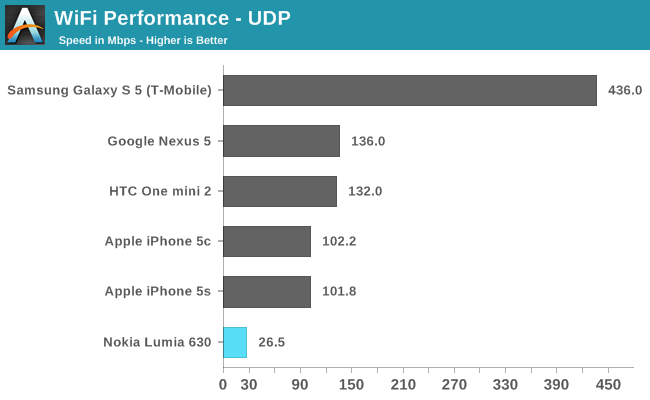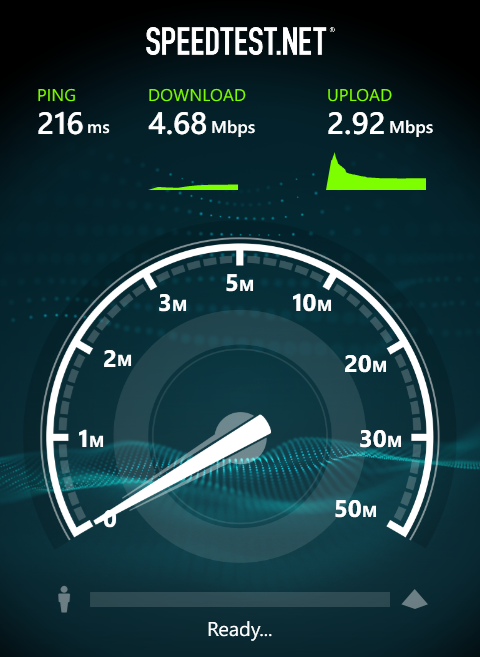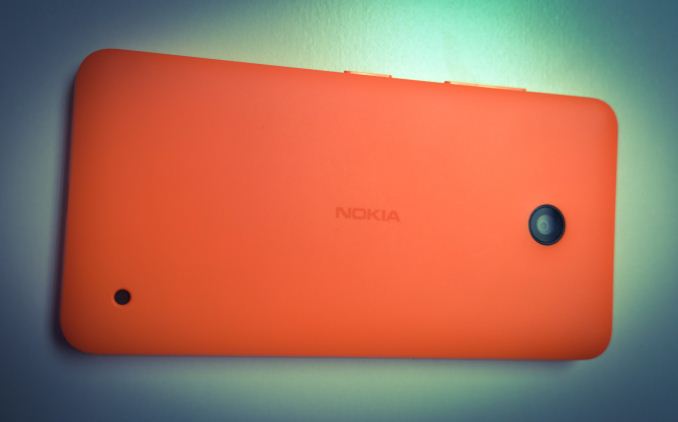Nokia Lumia 630 Review
by Brett Howse on July 22, 2014 8:00 AM EST- Posted in
- Smartphones
- Microsoft
- Nokia
- Mobile
- windows phone
WiFi
The Wi-Fi department is decidedly lacking, with the Lumia 630 only supporting 802.11b/g/n, and only on the 2.4 GHz bands. While I personally prefer the range 2.4 GHz gives me, people in more congested areas have come to rely on 5 GHz for quality connections. It’s not surprising that this is cut it seems to be one of the first things to go once budgets are looked at. For the budget, I can understand why it was done.

Once again we’re bumping into the easy to cull features on an affordable smartphone. While the Lumia 630 is 802.11n, it has a single 2.4 GHz antennae which results in connection speeds that max out at 65 Mbps. With overhead, I have yet to see sustained speeds of over around 27 Mbps, though I’ve seen the occasional peak speeds of around 40 Mbps. Certainly not great but it gets the job done I suppose.
Cellular
The Lumia 630 utilizes the Qualcomm MSM8226 SoC, and is therefore limited to 21.1 Mbps HSPA+ speeds. If you want LTE, you need to go with the Lumia 635 which uses the MSM8926. The 8226 is definitely a known part at this point, with it being the heart of quite a few smartphones including the Moto G. Download speeds are right what you’d expect for a HSPA+ device. As always, these numbers are skewed by the current load on whatever cell site you are attached to, so keep that in mind. The theoretical maximum speed is never going to be reached.
GNSS
Again, with the Qualcomm silicon at the heart of this device, we’re working with well known, and well tested parts such as the GNSS. The Lumia 630 supports Cellular and Wi-Fi assist and supports GPS, GLONASS, and BeiDou for location, and it locks quickly. Hopefully the days of poor location tracking are over.
Speaker
With just a single speaker on the back of the device, the Lumia 630 is not great for playing music. The quality of the sound is typical of most smartphones – tinny and very low dynamic range. The overall volume is decent though, assuming the speaker isn’t covered by your hand, which it normally would not be with the placement of the speaker grille.
For notifications, the speaker is adequate and provides ample volume so that you won’t miss a call or notification. The same can’t be said of the vibration mechanism. It’s too weak, and if the phone is on vibrate and in your pocket, it is very easy to miss a notification.












83 Comments
View All Comments
kspirit - Tuesday, July 22, 2014 - link
Incredibly detailed and excellent as usual. Thanks for all the info. I'm glad you clarified why the 930 doesn't have Glance. It confused me, because I thought it was something MS was killing off with WP8.1. Good to know that's not the case.kspirit - Tuesday, July 22, 2014 - link
Another thing I'd like to add is that the 630's display is not "real" ClearBlack. I have seen and owned devices with those, and my father has a 630, and this is most certainly NOT a CBD. It's marketed as such but there is no polarizer.DanNeely - Tuesday, July 22, 2014 - link
"But again the storage of only 8 GB is no problem at all due to the included microSD card being able to add another 128 GB if needed, and Windows Phone 8.1 supports SD cards better than any other mobile OS."Having ran into one major performance problem with using the SD slot on my WP8/8.1 phone, I don't know how true this is in general. Earlier this year I bought a 520 to play around with WP8 and to use as a music player when the risk of breaking it was high enough that I didn't want anything expensive.
My music collection is currently ~60GB/11,000 tracks so I figured that with a 64GB uSD card (class 10) I'd be able to load everything on the sdcard and be good to go. Unfortunately I found that wasn't the case. I often shuffle over my entire music collection instead of drilling down to a specific artist/album. This turned out to be a major problem on my 520.
With the original WP8.0 install attempting to do so froze the phone completely for between 5 and 15 minutes before returning to normal operation mode (at this point everything worked perfectly unless I restarted the phone or changed to a short playlist and then tried to go back to the long one). This problem affected XBox Music, Nokia Music and a few free players I found so it appears to be OS related. I tried upgrading to the developer preview build of WP8.1. This fixed the total phone lockup, but gave a new problem. With the giant playlist there is an ~30s delay between pressing next/previous song and the song being played changing.
With both OS versions this wasn't a problem with small play lists on the SD card or when playing back from internal flash (limited to shorter play lists due to lack of space).
I don't know if this is a problem with the SD implementation in particular, I'm using a class10 card so my card itself shouldn't be the problem, or due to the total size of the playlist swamping the CPU somewhere. I haven't tried filling the card up most of the way with images or video to see how well those apps behave; but this has left me rather skeptical of WP8's ability to effectively use a large SD card to replace internal storage.
silverblue - Tuesday, July 22, 2014 - link
I'm not sure but it may be scanning all your music upon starting the app.DanNeely - Tuesday, July 22, 2014 - link
I don't think so. The app launches as quickly as anything else on the phone does, and WP8 refuses to identify music/etc unless synced using an official app (vs just copied via explorer); and lists everything in the various category based lists (artist/genre/etc). The genre/etc based lists aren't possible without a full index already existing since (unlike artist) they can't be inferred from the file system.In 8.0, it was clearly doing some sort of pre-processing step before starting playback (but completely freezing the phone to the point of even hardware buttons being non-responsive is totally unacceptable); 8.1 doesn't do that, but has a major runtime performance problem as a result.
Kit Y - Tuesday, July 22, 2014 - link
DanNeely is definitely right on this issue, Windows Phone 8.1 removed the on board music and videos to Xbox Music/Video that is separated from the core platform to allow more timely updates to the music player.However, the current music player do suffer from a lot of bugs and slowdown as reported on r/WindowsPhone quite often and major compliant of many uses.
If I had the choice to make decision to balance cost and the features, I would forgo 4GBs of on board storage in exchange of ambient light sensor and 1GB of RAM, GG3 for Glance Screen and perhaps rename it to 530 as it seems to be a lot more appropriate given it's limitations and the similar launch price of 520 which we should see it to be drop to under $100 in many markets.
DanNeely - Tuesday, July 22, 2014 - link
I haven't tried any 3rd party players with 8.1; do you know if the architectural changes provide any scope for 3rd party players to preform better than Microsoft's?althaz - Tuesday, July 22, 2014 - link
The music app is currently being updated pretty regularly and is a LOT better today than it was a month ago.That said, there's plenty of scope for a developer to make a much faster app - I'm working on one at the moment. My plan is to make something pretty limited, but I would personally prefer a very basic app that's fast over one that is fully featured but slower.
skiboysteve - Tuesday, July 22, 2014 - link
the latest version of xbox music on WP8.1 resolves this exact issue. it now no longer scans for entire folders for music file changes every start up... it must use some indexing thing now. It also does scanning and updating in background if you're on wifi and plugged inAlexvrb - Tuesday, July 22, 2014 - link
Yeah they've been making some improvements on the latest updates. Overall the memory card support in WP 8.1 is great.As far as "Class 10" goes... it's almost a meaningless label. Even having a UHS-I rated card doesn't really tell you much. Unless you have read/write and IOPs figures for the memory card in question, it might as well be labeled "random flash card that I hope doesn't blow". I have an ADATA UHS-I microSD card that is rated at 1400/100 IOPs random read/write. Most card manufacturers don't even release those specs because they are so bad.
I really hope UHS-II picks up steam and they start releasing mSD variants and devices that support it. I've seen some UHS-II SD cards with IOPs twice as high as my card or better.